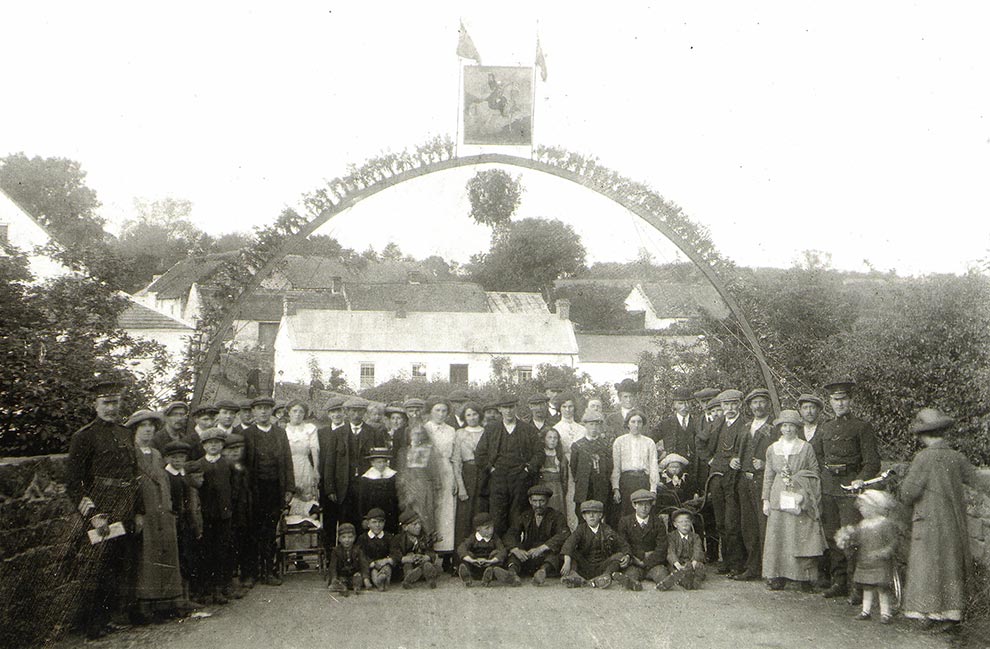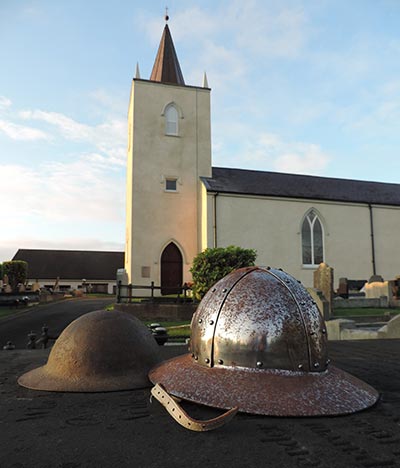There is a strong Orange tradition in Aghalee. An annual Orange Service is held each year in July and the local lodge lay a wreath at the annual Remembrance Service. Also, in any year when the 12th July parade is held in Aghalee, the parish normally provide some catering arrangements for participants and spectators.

There are now four Orange lodges around the parish area. Aghagallon and Ballycairn (which both meet in Aghalee, above the Parochail Hall), Soldierstown and Aghadavy. These four Lodges constitute Aghalee District L.O.L. No. 2.
Aghagallon Rising Sons of William L.O.L. 42 is reputed to be the oldest Lodge in the District, with a warrant granted in 1796.
Soldierstown Volunteers L.O.L. 224 was granted a warrant in 1874, but later suspended meeting in 1912 due to the World War I. Lodge meetings resumed after World War II and in 1965 the Lodge purchased Sammy Hill’s former home at Soldierstown crossroads as an Orange Hall.
Ballycairn Invincible Purple Star L.O.L. 236 was first mentioned in the minute book of Grand Lodge in 1798; further warrants were granted in 1823, 1829, 1856, 1891, 1903 and 1947. The Lodge retains roll and minute books dating back to 1872.
Aghadavy Purple Heroes L.O.L. 403 originally met in Aghagallon, moving to Aghadavy in the neighbouring parish of Ballinderry in 1874. Aghadavy hall has now been sold and the Lodge has been given permission to sit in the Orange hall in Aghalee.

In 1688, Williamite and Jacobite forces met in battle on the Scout Hill, Ballinderry. The Jacobites were overwhelmed and retreated southwards, only to be caught again in Magheramesk townland. It is said that during the course of the battle, Lord Blayney, who was in command, tied his horse to a thornbush which ever after was known as Blayney’s Bush. He was presumably the Baron Henry Vincent Blayney who until 1680 possessed the lands around Castleblayney and later commanded Williamite troops in counties Armagh and Monaghan. Blayney’s Bush grew near what is now the junction of Station Road and the A26 Glenavy Road. It was such a significant local landmark that when the original bush died, it was replaced by local residents. However, the bush is no longer there – possibly a casualty of the new road through the area.
It’s a popular local claim that King William (and his army of 15,000 men) may have spent a night in Aghalee en route to the Battle of the Boyne. A more reliable tradition, perhaps, states that, in 1690, King Willam rode from Hillsborough Castle to Trummery House to discuss the military campaign with Captain Spencer - most likely Brent Spencer, son or possibly grandson of Captain Henry Spencer.

A popular Orange ballad refers to the ‘bold Aghalee Heroes’ who ‘marched through the sweet Portadown’. The lyrics seem to refer to an Orange parade to Lurgan around the time of the 1798 United Irishmen rebellion.
A Lodge once existed known as Aghalee Heroes L.O.L. No. 192 (not No. 632 as in the song; the number may have changed some time in the C19th). It was also known locally as the Farmers and Doctors Lodge. The records of this lodge are lost, so very little is known about them.
On 15th January 1798, a letter appeared in the Belfast Newsletter from the Orange Societies of Aghalee, expressing ‘heartfelt satisfaction that … the Roman Catholics of the Parish of Culfaghtrim and Grange’ had rejected the cause of the United Irishmen, and expressing their desire to ‘co-operate with loyal men of any persuasion in the zealous defence of’ the crown and constitution. From this we can tell that, just two years after the establishment of the Orange Order, fourteen lodges existed in and around Aghalee.
Considering this, it seems strange that in 1838 the Ordnance Survey Memoirs record that ‘there is no Orange, Masonic or Ribbon lodges in the parish at present; none of the latter at any period’.
Around this time, Yeomanry forces were enlisted in many parts of Ireland. A local Yeomanry was formed at Soldierstown; although, it’s unclear whether any actual garrison building existed by this time - if so, its location was soon forgotten.
In ‘Heterogenia’ (1803), J. M. Johnston notes that the Yeomanry Corps on the Hertford Estate amounted to around 1000 men (two troops of cavalry and nine companies of infantry). It is also noted that the Soldierstown infantry had 100 men and was commanded by Mr. Gorman, Mr. Smyth and Mr. Fulton. Many names from the Company’s payroll are still familiar in the Soldierstown area today, such as Hull, Grant, Lavery and Moffitt.
Yeomanry Returns to the House of Commons (1834) list the officers of the Soldierstown Yeomanry as Captain Edward Usher, Lieutenant Jonathan Gilbert and Lieutenant Thomas Elliott.
In 1899, when the parish was building the Parochial Hall, the local lodge provided financial assistance. The building, therefore, remains a shared property – the ground floor is the Parochial Hall and the top floor is the Orange Hall. It is still managed by a group of local trustees, some representing the church and some representing the Orange Lodge.
